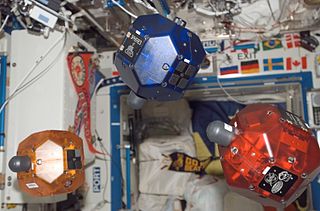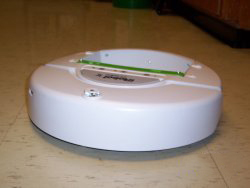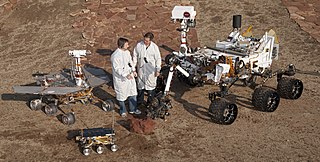An autonomous robot is a robot that acts without recourse to human control. Historic examples include space probes. Modern examples include self-driving vacuums and cars.

A humanoid robot is a robot resembling the human body in shape. The design may be for functional purposes, such as interacting with human tools and environments, for experimental purposes, such as the study of bipedal locomotion, or for other purposes. In general, humanoid robots have a torso, a head, two arms, and two legs, though some humanoid robots may replicate only part of the body. Androids are humanoid robots built to aesthetically resemble humans.

Canadarm or Canadarm1 is a series of robotic arms that were used on the Space Shuttle orbiters to deploy, manoeuvre, and capture payloads. After the Space Shuttle Columbia disaster, the Canadarm was always paired with the Orbiter Boom Sensor System (OBSS), which was used to inspect the exterior of the shuttle for damage to the thermal protection system.

Dextre, also known as the Special Purpose Dexterous Manipulator (SPDM), is a two-armed robot, or telemanipulator, which is part of the Mobile Servicing System on the International Space Station (ISS), and does repairs that would otherwise require astronauts to do spacewalks. It was launched on March 11, 2008, on the mission STS-123.

Rashtreeya Vidyalaya College of Engineering is an autonomous private engineering college in Bangalore, Karnataka, India. It was established in 1963 under the Rashtreeya Sikshana Samithi Trust (RSST) and was one of the earliest self-financing engineering colleges in the country. It is affiliated with the Visvesvaraya Technological University, Belgaum. In 2008, the college was given autonomous status.

A robonaut is a humanoid robot, part of a development project conducted by the Dexterous Robotics Laboratory at NASA's Lyndon B. Johnson Space Center (JSC) in Houston, Texas. Robonaut differs from other current space-faring robots in that, while most current space robotic systems are designed to move large objects, Robonaut's tasks require more dexterity.

A mobile robot is an automatic machine that is capable of locomotion. Mobile robotics is usually considered to be a subfield of robotics and information engineering.

The Synchronized Position Hold Engage and Reorient Experimental Satellite (SPHERES) are a series of miniaturized satellites developed by MIT's Space Systems Laboratory for NASA and US Military, to be used as a low-risk, extensible test bed for the development of metrology, formation flight, rendezvous, docking and autonomy algorithms that are critical for future space missions that use distributed spacecraft architecture, such as Terrestrial Planet Finder and Orbital Express.
Modular self-reconfiguring robotic systems or self-reconfigurable modular robots are autonomous kinematic machines with variable morphology. Beyond conventional actuation, sensing and control typically found in fixed-morphology robots, self-reconfiguring robots are also able to deliberately change their own shape by rearranging the connectivity of their parts, in order to adapt to new circumstances, perform new tasks, or recover from damage.

iRobot Create is a hobbyist robot manufactured by iRobot that was introduced in 2007 and based on their Roomba vacuum cleaning platform. The iRobot Create is explicitly designed for robotics development and improves the experience beyond simply hacking the Roomba. The Create replaces its Roomba predecessor's vacuum cleaner hardware with a cargo bay that also houses a DB-9 port providing serial communication, digital input & output, analog input & output, and an electric power supply. The Create also has a 7-pin Mini-DIN serial port through which sensor data can be read and motor commands can be issued using the iRobot Roomba Open Interface (ROI) protocol.

Robotics is the interdisciplinary study and practice of the design, construction, operation, and use of robots.

Willow Garage was a robotics research lab and technology incubator devoted to developing hardware and open source software for personal robotics applications. The company was best known for its open source software suite Robot Operating System (ROS), which rapidly became a common, standard tool among robotics researchers upon its initial release in 2010. It was begun in late 2006 by Scott Hassan, who had worked with Larry Page and Sergey Brin to develop the technology that became the Google Search engine. Steve Cousins was the president and CEO. Willow Garage was located in Menlo Park, California.

The Exploration Gateway Platform was a design concept proposed by Boeing in December 2011 to drastically reduce the cost of Moon, near Earth asteroids (NEAs), or Mars missions by using components already designed to construct a refueling depot and servicing station located at one of the Earth–Moon Lagrange points, L1 or L2. The system claims its cost savings based on an ability to be reused for multiple missions such as a launch platform for deep space exploration, robotic relay station for moon rovers, telescope servicing and a deep space practice platform located outside the Earth's protective radiation belts.
Construction 3D Printing (c3Dp) or 3D construction Printing (3DCP) refers to various technologies that use 3D printing as a core method to fabricate buildings or construction components. Alternative terms for this process include "additive construction." "3D Concrete" refers to concrete extrusion technologies whereas Autonomous Robotic Construction System (ARCS), large-scale additive manufacturing (LSAM), and freeform construction (FC) refer to other sub-groups.

NASA's Lunabotics Challenge

Nicolaus Adam Radford known as Nic Radford is an American engineer, roboticist, inventor, and entrepreneur raising over $250mm in funding for his companies. He is the former president and CEO of Nauticus Robotics, Inc. (NASDAQ:KITT) a robotics firm he co-founded. He also founded Jacobi Motors, his company spun out of HMI to commercialize his variable flux motor research from graduate school. He also started Rad Capital Ventures to invest in the trading of electricity. Prior to forming HMI, he spent 14 years at Lyndon B. Johnson Space Center's Dexterous Robotics Laboratory at NASA in Houston, Texas. Radford was the principal investigator tasked with leading the development of Valkyrie for participation in the 2013 DARPA Robotics Challenge (DRC) and NASA's future Mars robotics missions.
Gazebo is an open-source 2D/3D robotics simulator that began development in 2002. In 2017, development forked into two versions, known as "Gazebo", the original monolithic architecture, and "Ignition", which had moved to becoming a modernized collection of loosely coupled libraries. Following a trademark obstacle in 2022 regarding their use of the name "Ignition", Open Robotics took the opportunity to switch the version names, dubbing the original fork "Gazebo Classic" and the new, modern fork "Gazebo".

Astrobee is a robotic system developed by the US space agency NASA to assist astronauts aboard the International Space Station (ISS). Astrobee consists of three 12.5-inch cube-shaped robots named Honey, Queen, and Bumble, along with software and a docking station for recharging. Astrobee was created to perform some routine tasks on the ISS, allowing astronauts to focus on tasks which require human activities.

Valkyrie, also known as R5, is a humanoid robot developed by NASA. Its design and development started in October 2012 at the Lyndon B. Johnson Space Center. The primary objective was to create a robot capable of supporting future NASA missions, whether by performing tasks in advance of human arrival on other planets or by serving as an assistant to human teams during missions.














